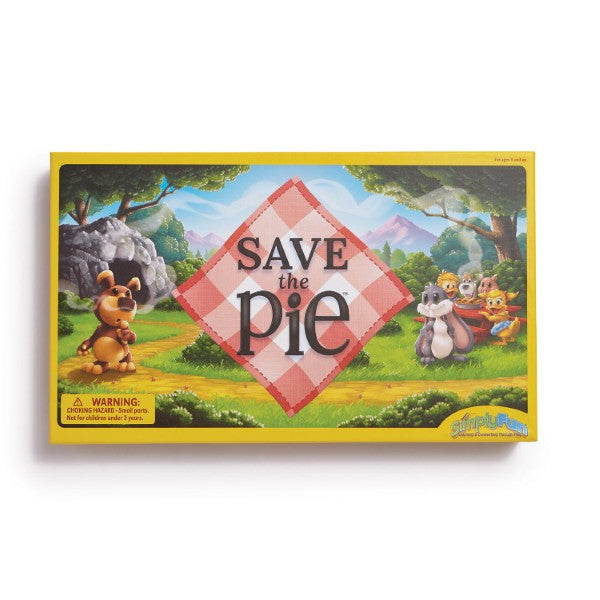
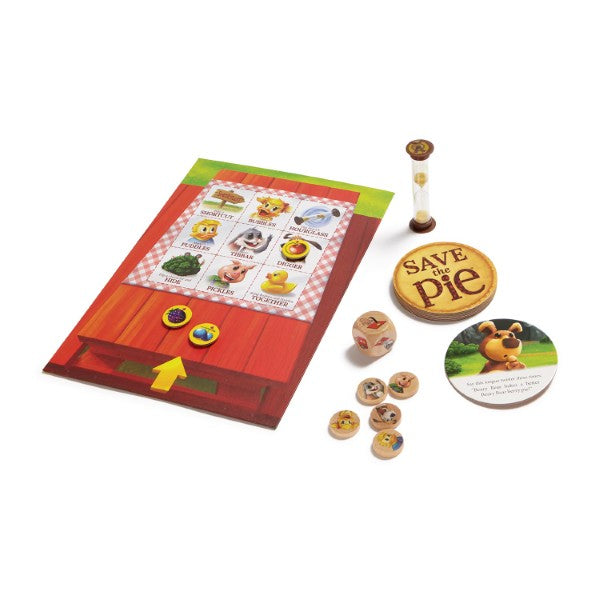
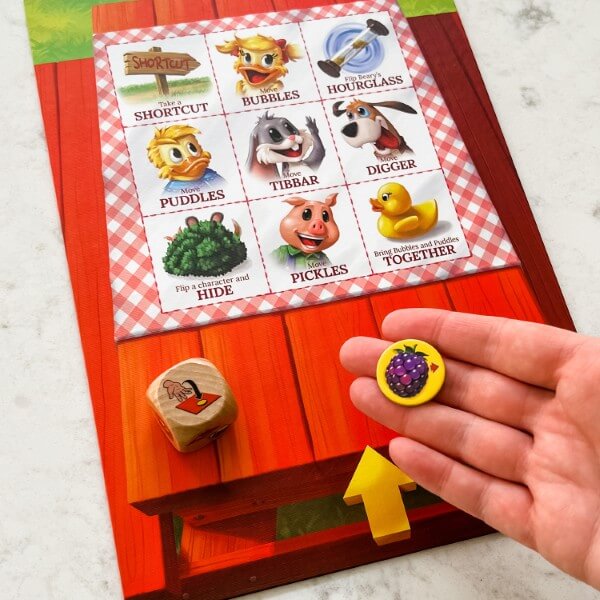
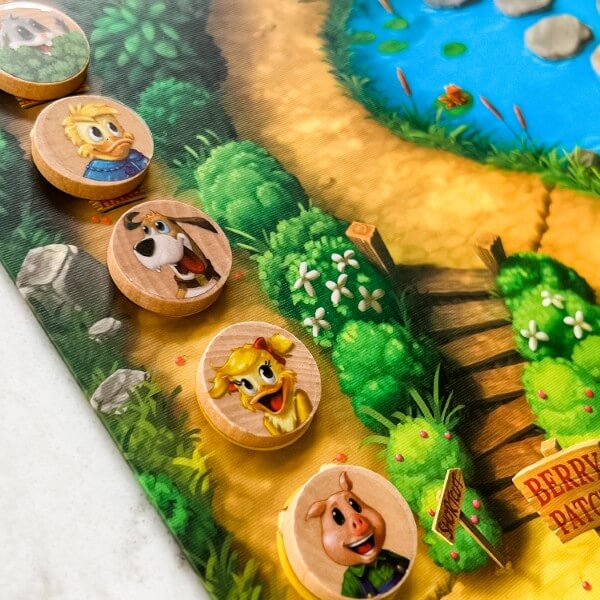
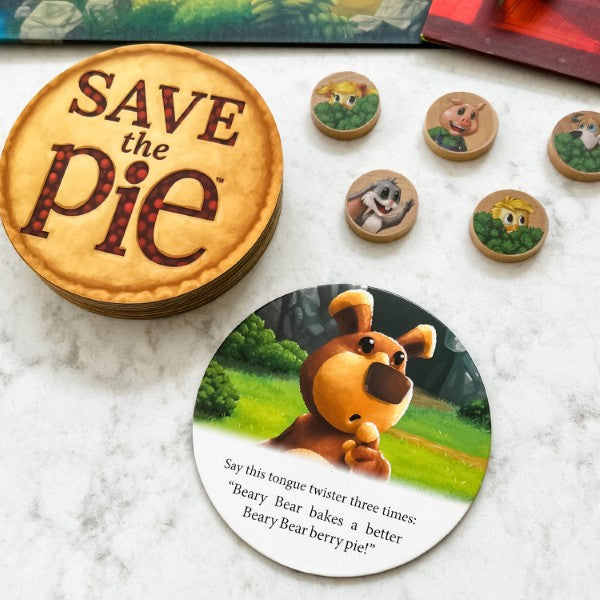
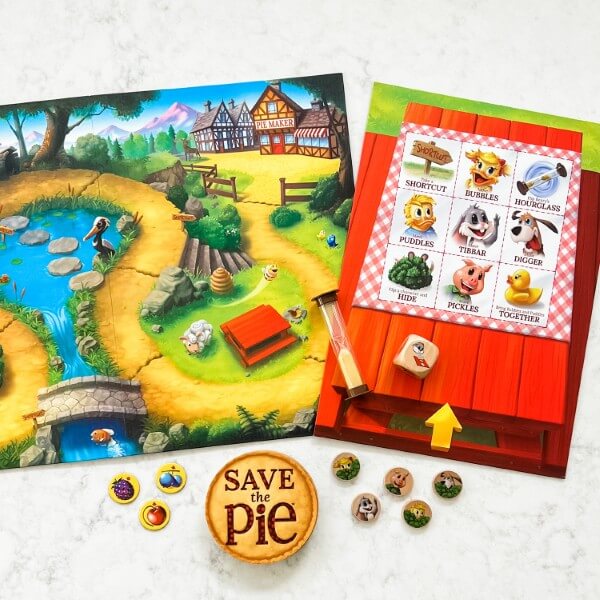
Collapsible content
Tibbar and his friends are back and they want to surprise their friend Beary with his favorite pie, but Beary Bear is very hungry for the sweet smelling berries on the trail. The Buddies need to save the pie by rushing the berries to the Pie Maker before Beary eats them all. Today we are going to see how we can help them!
Save the Pie is a fun packed cooperative game where Players work together, performing actions and trying to help each other move the Buddies across the board to the Pie Maker Space.
Save the Pie can be played with as few as 2 to as many as 6 players and everyone age 6 and up can help Tibbar and his friends save the pie!
Inside the Save the Pie game box you’ll find One game board, on which Tibbar and his helpers will travel, and One action board that tells players what to do.
• There are also Five wooden character pawns that represent the buddies, three berry tokens that players will use to decide what action they take, one six sided die that determines what action the player takes and 10 activity cards that players must do if they are unsuccessful in completing their action.
Save the Pie builds collaboration skills as children learn how to succeed by working together. Fun activities in the game help young players develop fine motor skills too. The game incorporates action-based strategy involving all players so there are no individual winners or losers. With teamwork, everyone wins!
Before playing Save the Pie, there is, as they say, “some assembly required.”
First, affix the 10 character stickers to their appropriate positions on both sides of the 5 character pawns. Make sure each pawn features the same character on both sides of the piece. Then apply the 6 die stickers to each side of the wooden die, as shown. Now, you’re ready to go!
Lay the large game board in the middle of the table and place the character pawns on the Berry Patch space. Place the shuffled activity cards in a stack beside the board. Finally, put Beary’s hourglass on either the easy, medium or hard Beary space on the board. If you’re playing for the first time, it’s recommended that you place it on the easy space.
The starting player gets the action board, the die and all three Beary tokens. Play begins when Beary’s hourglass is turned over for the first time. Taking turns, each player tries to move the character pawns across the board to the Pie Maker space. Each time the hourglass drains, it gets moved forward one space on the board and flipped over again. Players have to try to keep the pawns ahead of Beary’s hourglass.
To play, the first player rolls the die and, as the die directs, the player then drops, flicks, pushes, slides, tosses or blows a berry token onto the action board where it lands on an action. The player must then perform the action on the board, like move one of the characters, take a shortcut, flip the hourglass, flip a character and hide or bring Bubbles and Puddles together.
Throughout the turn, the player must keep an eye on Beary’s hourglass to see if the sand is drained. If it is, he must flip it and move it forward on the board.
Depending on the where the hourglass lands, three things can happen. Refer to the instruction booklet for those options.
A turn is over when the player has performed all three steps: 1) checking Beary’s hourglass to see if sand remains and if not, turning it over and moving it one space ahead, 2) rolling the die and using a berry token, and 3) performing the action shown on the board. When the turn is over, the player passes the die, the action board and the berry tokens to the next player, and play continues clockwise.
Since Save the Pie is a cooperative game, all players win or lose together, depending on what happens.
The game ends when EITHER:
All players WIN by getting all five character pawns to the Piemaker space before Beary’s hourglass, or four of the five character pawns reach the Pie Maker space and the remaining pawn is turned face-down, showing the hidden side.
OR
All players LOSE if Beary’s hourglass reaches a space occupied by one or more face-up pawns, or Beary’s hourglass moves past a space occupied by a face-down pawn.
With Simply Fun’s Save the Pie, players help Tibbar, Pickles, Digger, Bubbles and Puddles get to the Pie Maker before our favorite bear gets all the berries!


Core Standard*: Science
Science
- Physical Science – Force and Motion
- Force Makes Things Move
- In prior grades students learned to use appropriate words to describe the position and motion of objects and the effects of forces on objects. In grades 2-3 students learn that forces work not only to push and pull objects, but also affect objects when they are dropped or thrown. Whenever the motion of an object changes, there is a force involved. Greater forces on a given object result in greater changes of motion. In addition to being able to describe how forces change the motion of objects, students are expected to measure the position of objects using measuring instruments such as rulers. Students can also measure time to the nearest minute. Emphasis should be on comparisons of forces and motions rather than on calculation so that students develop conceptual understanding of how forces make things move. Grade Levels 2nd and 3rd


Explore
What Does Child Do To Use Skill In The Game?
Players examine the Save the Pie game board looking at the locations of the different characters, Beary's Hourglass and the available shortcuts. They also explore different methods for placing Berry Tokens on the Action Board.
How Parents Can Assist Learning
Remind children to look at which characters are on a shortcut space before they roll the die and use a Berry Token on the Action Board.
Learning Implications and Educator Support
The Action Board in Save the Pie is a good way for children to explore the scientific properties of motion, gravity and force. To encourage scientific curiosity and experiential learning, allow children to try out all the different Actions before starting the game.
Determine
What Does Child Do To Use Skill In The Game?
Players make determinations several times a turn, including which way to place a Berry Token on the Action Board, what action to take, how to perform an Activity, and which Character Pawn to move.
How Parents Can Assist Learning
If children have difficulty with any of the approaches to placing Berry Tokens on the Action board, consider allowing them to pick their favorite way such as Blow or Toss.
Learning Implications and Educator Support
As children take a turn ask them to interpret the meaning of the symbol on the die, the meaning of arrows, and other symbols on the action board.
Remember
What Does Child Do To Use Skill In The Game?
Several of the Activity Cards require Players to remember something such as a favorite song or joke.
How Parents Can Assist Learning
No special adult support required. However, if the child is having a hard time remembering, the adult can give clues to help the child remember.
Learning Implications and Educator Support
No special adult support required. However, if the child is having a hard time remembering, the adult can give clues to help the child remember.
Predict
What Does Child Do To Use Skill In The Game?
Save the Pie involves light predicting as Players where Berry's Hourglass will move next and how soon so that they move or flip over the appropriate Character Pawns.
How Parents Can Assist Learning
No special adult support required. However, the adult my need to remind players to keep an eye on the timer.
Learning Implications and Educator Support
Predicting involves skills like analysis, observation, empathy and interpretation.
No special educator support required. Teachers can encourage children to predict where their Berry Token will land. Remind them to anticipate the length of time remaining on the timer.
Plan
What Does Child Do To Use Skill In The Game?
Players plan which Effect to target on the Action Board.
How Parents Can Assist Learning
If needed, remind children that they need to make sure that Berry's Hourglass does not catch up to any space where a Character Pawn is face up or face down, unless all the other Character Pawns will be at the Pie Maker on the next turn. This will help them plan their target for their Berry Tokens. For example, if Pickles is one space ahead of Berry, then the children want to get their Tokens to land on Pickles so they can move Pickles forward.
Learning Implications and Educator Support
Planning is an important skill for developing strategic thinking and reaching a goal.
If needed, remind children that they need to make sure that Berry's Hourglass does not catch up to any space where a Character Pawn is face up or face down, unless all the other Character Pawns will be at the Pie Maker on the next turn. This will help them plan their target for their Berry Tokens. For example, if Pickles is one space ahead of Berry, then the children want to get their Tokens to land on Pickles so they can move Pickles forward.
Experiment
What Does Child Do To Use Skill In The Game?
Children experiment with different ways to manipulate the Berry Tokens to get them to go where they want it to go. The need to adjust directionality, force, location of token, and finger and hand movements.
How Parents Can Assist Learning
The Action Board in Save the Pie is a good way for children to explore the scientific properties of motion, gravity and force. To encourage scientific curiosity and experiential learning, allow children to try out all the different Actions before starting the game.
Learning Implications and Educator Support
The Action Board in Save the Pie is a good way for children to explore the scientific properties of motion, gravity and force. To encourage scientific curiosity and experiential learning, allow children to try out all the different Actions before starting the game.
Practice
What Does Child Do To Use Skill In The Game?
As they play the game repeatedly, Players get better at using the different actions to land the Berry Tokens on the desired Effect.
How Parents Can Assist Learning
No special support required.
Learning Implications and Educator Support
No special support required.
Solve
What Does Child Do To Use Skill In The Game?
Save a Pie requires cooperative problem-solving as Players work together to move all the Character Tokens to the Pie Maker in time.
How Parents Can Assist Learning
Save the Pie is a great way for children to develop cooperation and collaboration skills, as well as strategic problem-solving as the weigh risk-reward of moving different characters or flipping others over.
Parents can support cooperative play by having children quickly discuss what Effect they want to target, and then let the turn-taking child try to hit the target. Also, children may want to select a reader for the Activity Cards.
Additionally, as the game proceeds, Berry's Hourglass will be getting closer to the Character Pawns. If needed, point out the Character Pawns that are at the most immediate risk to help the children respond to what is happening on the board. Also, parents can be the time keeper, letting the children know that the Hourglass is almost run out, which may help the children make timely decisions.
Learning Implications and Educator Support
Save the Pie is a great way for children to develop cooperation and collaboration skills, as well as strategic problem-solving as the weigh risk-reward of moving different characters or flipping others over.
Parents can support cooperative play by having children quickly discuss what Effect they want to target, and then let the turn-taking child try to hit the target. Also, children may want to select a reader for the Activity Cards.
Additionally, as the game proceeds, Berry's Hourglass will be getting closer to the Character Pawns. If needed, point out the Character Pawns that are at the most immediate risk to help the children respond to what is happening on the board. Also, parents can be the time keeper, letting the children know that the Hourglass is almost run out, which may help the children make timely decisions.
Demonstrate
What Does Child Do To Use Skill In The Game?
Children who are successful at getting Berry Tokens to land where they want can demonstrate their technique to others.
How Parents Can Assist Learning
Parents can demonstrate techniques and provide suggestions for how to manipulate the Berry Tokens.
Learning Implications and Educator Support
Teachers can ask peers who are successful to demonstrate and explain their techniques for manipulating the Berry Tokens.
*Data compiled from CCSSI ELA Standards, WA Science Standards, and Washington Social Studies Standards


Cognitive
Suggestions for How to Modify Play Experience
This is a team game, so children with cognitive delays are supported in their efforts by other players. The directions are complex, so help the child by walking them through each step of a turn one step at a time. Children will need constant support to be able to understand the complex set of steps in playing.
Model actions illustrated on the die, so the child sees what is meant and can imitate the actions. Demonstrate the meaning of the arrows on berry tokens. Help children to know what to do with their character pawns based on where the berry tokens land. Talk about each side of character pawns, so children see the face-up and face-down sides of the character pawns.
Save the Pie is not recommended for children with significant cognitive delays.
Communication
Suggestions for How to Modify Play Experience
If children have difficulty understanding complex directions, Save The Pie will be challenging. Model actions illustrated on the die, so the child sees what is meant and can imitate the actions. Demonstrate the meaning of the arrows on berry tokens. Help children to know what to do with their character pawns based on where the berry tokens land. Talk about each side of character pawns, so children see the face-up and face-down sides of the character pawns.
Save the Pie encourages children to discuss their actions and perform various actions. Children with language production concerns may need support to be able to say what they are going to do based on the results of each maneuver in the game.
Sensorimotor
Suggestions for How to Modify Play Experience
Children with fine motor challenges will find this game challenging. If the child can perform one of the actions on the die, the team can allow the child to always use this method on the action board. Turning the timer and the character pawns may also be difficult. Other players may need to assist.
Social Emotional/Behavioral
Suggestions for How to Modify Play Experience
Children with impulsive behaviors may find Save the Pie challenging. There are several steps in each turn, so players need to pay attention and be patient. The game needs to move quickly, however, so with encouragement these children may enjoy the fast pace.
It is challenging to get the berry tokens to land in a desired spot on the action board. This may be frustrating for some children. Allow one do-over so children can practice their move if needed.
Save The Pie is a cooperative game, which can help children develop social skills. Encourage children to talk about plays and cheer each other on.
Vision
Suggestions for How to Modify Play Experience
Save the pie is not appropriate for children with uncorrected vision impairments.
Hearing
Suggestions for How to Modify Play Experience
Children with hearing loss may be able to play if they can read the action cards and discuss plays with signs and/or gestures.
Because this is a cooperative game discussion is important. This will be difficult if players do not all use the same communication system (e.g., verbal, sign language).
*Data compiled from CCSSI ELA Standards, WA Science Standards, and Washington Social Studies Standards


Autism Special Considerations
Appears to ignore other's communication and/or has difficulty giving eye contact to a communication partner
Is This Game Appropriate for Child with Characteristic? Yes
Can Child with Characteristic Play Game w/o Modification? Yes
Strategies for Developing Compensatory Skills:
Although verbal communication is not necessary, players must watch and listen to others moves to plan a strategy for how to reach the goal. Encourage children to verbalize what they did, as well as what they see others do.
Has difficulty understanding complex verbal directions
Is This Game Appropriate for Child with Characteristic? No
Can Child with Characteristic Play Game w/o Modification? No
Strategies for Developing Compensatory Skills:
Directions for Save the Pie are complex, in that players don't have an assigned token, arrows have abstract meanings, and play changes with each turn. For this reason, the game may not be appropriate for children with autism or other cognitive and social comprehension concerns.
Uses vocabulary inaccurately or demonstrates echolalia (repeating another's speech)
Is This Game Appropriate for Child with Characteristic? Yes
Can Child with Characteristic Play Game w/o Modification? No
Strategies for Developing Compensatory Skills:
Having echolalia should not prevent a child from playing, but may be annoying to other players. The adult can provide alternatives for the child. For example, if the child is repeating a phrase, say, "Tell me where your berry landed."
Gets stuck repeating a verbal topic or physical actions and/or has difficulty attending to others' actions or topic.
Is This Game Appropriate for Child with Characteristic? Yes
Can Child with Characteristic Play Game w/o Modification? No
Strategies for Developing Compensatory Skills:
Has difficulty producing speech/communication
Is This Game Appropriate for Child with Characteristic? Yes
Can Child with Characteristic Play Game w/o Modification? Yes
Strategies for Developing Compensatory Skills:
Communication is not necessary, but should be encouraged. Other players should be encouraged to comment and ask simple questions to elicit simple communication. "Did you flip or slide?" Giving a choice of two options allows the child to narrow down what needs to be said and also provides a verbal model.
Has difficulty sequencing multi-step actions and/or doing complex abstract tasks
Is This Game Appropriate for Child with Characteristic? No
Can Child with Characteristic Play Game w/o Modification? No
Strategies for Developing Compensatory Skills:
Save the Pie is not recommended for children who cannot process multiple steps. Each turn in the game requires multiple steps and the actions are different with each turn. Children also need to be able to "read" the symbols for actions they are to perform on the action board. This may be too abstract for some children. Children may be able to play Save the Pie with a partner who can assist by explaining moves and demonstrate actions.
Demonstrates difficulty initiating and maintaining social interactions
Is This Game Appropriate for Child with Characteristic? Yes
Can Child with Characteristic Play Game w/o Modification? No
Strategies for Developing Compensatory Skills:
Children can play by concentrating on the game rather than having a social exchange, but discussion should be encouraged. Ask questions such as, "Where did his berry land?" to encourage discussion.
Acts out or demonstrates avoidance behaviors when frustrated, overwhelmed, or needs more sensory input.
Is This Game Appropriate for Child with Characteristic? Yes
Can Child with Characteristic Play Game w/o Modification? No
Strategies for Developing Compensatory Skills:
Reduce extraneous noise.
A weighted vest worn during the game may provide additional pressure input and thus reduce fidgeting due to sensory needs.
Practice a phrase to ask for help and role play situations in the game where it is needed.
Provide techniques for self-calming, such as holding a special toy.
Allow time for movement. For example, a child who needs to move frequently can be given an opportunity to 'celebrate' their turn by running around the table or jumping up and down 10 times.
Note: Children with autism may have difficulty making precise controlled movements, such as those required to get the berry onto a spot on the action board. Inability to perform these actions may cause frustration and acting out behaviors. It may help to partner the child with autism with another player who can help with the fine motor actions.
Has short attention span for non-preferred activities
Is This Game Appropriate for Child with Characteristic? Yes
Can Child with Characteristic Play Game w/o Modification? No
Strategies for Developing Compensatory Skills:
Unless fine motor activities are preferred, children with autism may find the game too challenging. The timer helps to speed up the game, but the game requirements may prove distracting.
Needs sameness or consistent routines and/or has difficulty with transitions from one activity to another
Is This Game Appropriate for Child with Characteristic? No
Can Child with Characteristic Play Game w/o Modification? No
Strategies for Developing Compensatory Skills:
Because the moves change with each turn, this may be frustrating to some children with autism. If so, the game is not recommended.
Play games at the same time every day, so the child anticipates the game routine.
Change the location of the game, so the child may play in different rooms, at the table, or on the floor. This will build tolerance for variation.
Prepare the child a head time for the introduction of a new game. Talk about aspects that will be motivating for the child, and let her explore the parts of the game before setting out the whole game.
Has difficulty understanding others' feelings, intentions, and the reasons for others' actions.
Is This Game Appropriate for Child with Characteristic? Yes
Can Child with Characteristic Play Game w/o Modification? Yes
Strategies for Developing Compensatory Skills:
Players do not need to understand others' feelings. It is a cooperative game, so competitive strategy is not needed. Players can talk about their own feelings as they play the game to model for the child with autism. "I'm mad. I wanted to land on the duck!" When the child with autism takes a turn, ask, "Are you happy or sad about where you landed?"
*Data compiled from CCSSI ELA Standards, WA Science Standards, and Washington Social Studies Standards


Extra Ways to Play the Game
Pick the side of die you want to use, instead of rolling it. This allows children to choose their preferred action.
Materials Needed
No additional materials are needed.
Developmental Benefits
Children feel like they have more control when they can make choices. The ability to determine what you think will help build independence and self confidence. With practice children may also begin to determine what strategies are more successful.
*Data compiled from CCSSI ELA Standards, WA Science Standards, and Washington Social Studies Standards
Game Details
- 1 Game Board
- 5 Character Pawns
- 1 Six-Sided Die
- 1 One-Minute Timer
- 1 Action Board
- 3 Berry Tokens
- 10 Activity Cards
- 1 Rules Booklet







